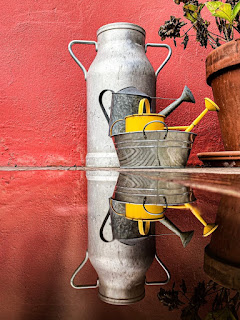I recently spent some time house-sitting for a family member who has some substantial plantings around the property. When I began my sojourn there, we were experiencing extreme heat and the watering chores were focused on dealing with that. But within a few days, we had some intensely powerful monsoon storms, the ground was waterlogged, and flash floods were happening. This sudden change made my caretaking duties less obvious and more stressful. To water or not to water was and continues to be the big question. Luckily, there are answers, especially in a well-though-out watering plan.
All watering strategies should come from an understanding that water resources are finite and the only way to maintain a healthy garden long-term is by using less water. Or by watering smarter. Many municipalities (especially in the drought-stricken West) have or are considering putting restrictions on water use, so you will be ahead of the game when planning to water properly but less. The mantra to follow should be: “Water as much as needed while using as little as possible”. To that end, here are some guidelines:
- HOW TO WATER -
WATER EARLY IN THE MORNING, OR MAYBE IN THE EVENING – Watering in the daytime is simply wasteful as you lose a good bit of it to evaporation, especially in summer. Here in Arizona, we discourage evening watering because that is when water use is at its highest. But it can be done safely then or even later at night due to our dry conditions. In more humid climates, you run the risk of welcoming disease if your plants are put to bed with wet leaves. These are also favorable conditions for snails to make themselves at home. It’s probably best to just water in the morning – and in the hottest places this can be as early as before dawn.
MULCH AND MULCH SOME MORE – Where possible, add mulch around your plants to help hold water in, reduce runoff, and lower the surface soil temperature. Avoid coco peat, however, as it will hold the water and makes a soggy mess that can encourage disease.
WATER SLOWLY, DEEPLY AND THOROUGHLY – You don’t want to squander water on leaves where it will evaporate rapidly, especially since plants need water most in their root zones. In general, water needs to move 6”-12” into the soil to get to the roots and this can take more than a couple of minutes, so soak slowly (soaker hoses work well when monitored carefully). Or water some, walk away and water elsewhere, and then come back to water more. Watering deep in the soil encourages plant roots to grow down, creating stronger and healthier root systems. In our recent storms, a lot of large trees have fallen and many of these were the victims of quick and shallow watering. They had responded to this type of watering by developing wide-spread, surface level roots that aren’t able to hold up to heavy rain or strong winds.
USE A WATERING CAN AND NOT A HOSE –- HOW MUCH WATER TO USE –
YOU SHOULD PROBABLY BE USING LESS WATER THAN YOU ARE – According to this EPA article, landscaping typically requires one inch of water a week. But that seems rather arbitrary to me and definitely too much in many circumstances. Rather than seeking a way to make sense of the amount of water you use, it’s far better to consider ways to cut down. Xeriscape practices have been popular in southern Arizona for decades but is no longer just for desert communities. With xeriscaping you can have the beautiful landscaping you want – with less yard maintenance - while reducing water and fertilizer usage, embracing native species, and improving the soil.
STRETCH YOUR RAIN RESOURCES – People have been using grey water on gardens since gardens were invented and it’s still a good idea. Collecting and harvesting rainwater is also nothing new, but surprisingly few people take advantage of this literal gift from the heavens. Although they are nice, you do not need a fancy collection system; you can start small with buckets or something similar (just be sure to use the water and not let it sit and become a mosquito breeding ground). If your rainstorm is a gentle one, push your container plants out so they can get the good stuff straight from the sky. Lightning-packed rain events can be a little terrifying, but they offer more than water as the lightning can help deliver nitrogen into the soil (and your plants love that). That doesn’t mean that you should go out amongst lightning strikes to put out your favorite potted plant, but it does mean that what you have growing out there is appreciating the charge they’re getting. If you have recently received a lot of rainfall, do not continue to water as usual, wait until the soil has dried out. Turn off the irrigation and re-evaluate. This especially true in arid places where plants are adapted to dry soil. Keep in mind that over-watering can kill as surely as too little watering can.Take Care
Submitted by Pam











No comments:
Post a Comment